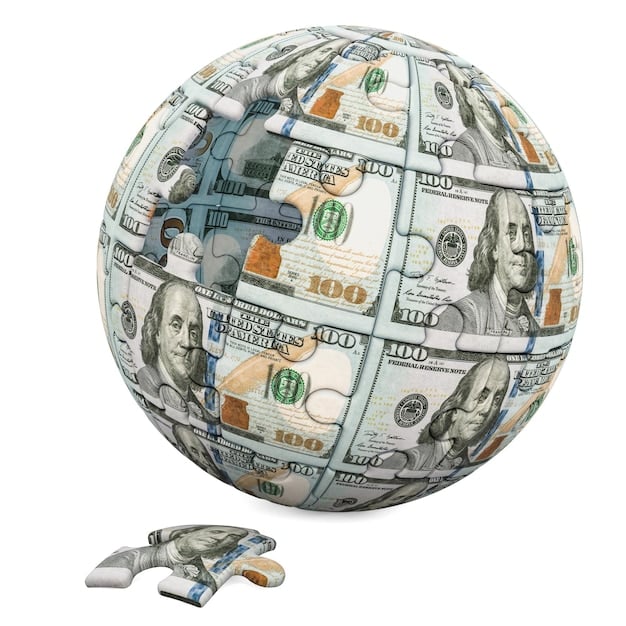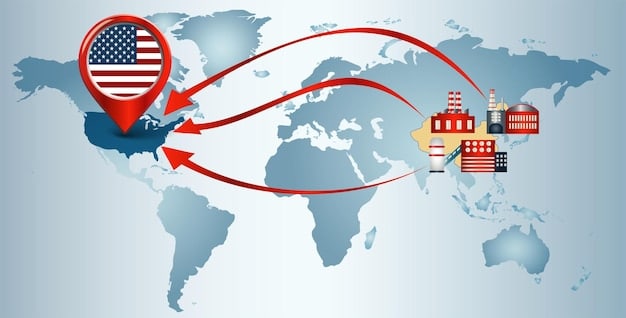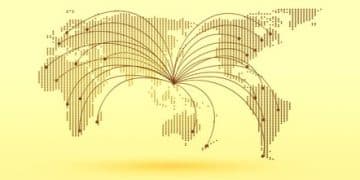US Foreign Aid: Where Does $50 Billion Go and What Are the Results?

The perennial question of where the United States’ substantial foreign aid, often exceeding $50 billion annually, is allocated and what tangible results it yields remains central to public and policy debates, encompassing diverse objectives from humanitarian relief to fostering economic stability and national security interests.
The concept of foreign aid, a cornerstone of international relations for decades, often sparks intense debate. When the United States commits tens of billions of dollars annually, taxpayers naturally ask: US foreign aid: where is the $50 billion going and what results are taxpayers seeing? This complex question involves a multitude of agencies, objectives, and varied outcomes, impacting global stability, humanitarian efforts, and American strategic interests.
Understanding the Landscape of US Foreign Aid
The United United States stands as the world’s largest donor of foreign aid, a commitment reflecting a complex interplay of humanitarian concerns, geopolitical strategy, and economic interests. This isn’t a monolithic cash transfer; rather, it’s a multifaceted system involving various forms of assistance channeled through numerous government agencies, non-governmental organizations, and multilateral institutions.
Diverse Objectives and Instruments
US foreign aid is designed to achieve a spectrum of objectives. From alleviating global poverty and improving public health to promoting democracy and supporting post-conflict reconstruction, the goals are broad and often interconnected. It’s not just about money; aid can take the form of technical assistance, food programs, military assistance, or even debt relief. Each instrument is chosen based on the specific context and desired outcome.
Consider, for example, the stark humanitarian crises driven by natural disasters or protracted conflicts. In such scenarios, emergency relief, including food, water, and medical supplies, becomes paramount. This immediate response is often followed by longer-term recovery and development efforts. At the same time, aid can be strategically deployed to bolster the security of allies or combat terrorism, demonstrating its dual nature as both a humanitarian tool and a foreign policy instrument.
The sheer volume of aid, often surpassing $50 billion annually, necessitates a detailed examination of its allocation and effectiveness. While the exact figures fluctuate year to year based on congressional appropriations and global events, the consistent scale of investment underscores its importance in U.S. foreign policy. Understanding this landscape requires delving into the primary recipients, the types of aid provided, and the mechanisms through which it is disbursed.
Key Agencies and Their Roles in Aid Distribution
The administration of US foreign aid is a collaborative effort involving several key government agencies, each with a distinct mandate and operational focus. These agencies work both independently and in coordination to deploy resources effectively across the globe. Understanding their individual roles provides clarity on how the $50 billion budget is managed and directed.
USAID: The Development Arm
The United States Agency for International Development (USAID) is arguably the most prominent player in the foreign aid arena, serving as the primary US government agency for development and humanitarian assistance. USAID’s mission is expansive, ranging from addressing long-term development challenges such as poverty, maternal and child health, and education, to responding to humanitarian crises. Its programs often involve partnerships with local governments, civil society organizations, and private sector entities to build sustainable capacity within recipient nations. The agency’s work is driven by the belief that investing in global development fosters stability and prosperity, which in turn serves U.S. interests.
Department of State: Diplomacy and Security Assistance
While USAID focuses on development, the Department of State uses foreign aid as a critical tool for diplomacy and national security. The State Department manages large portions of security assistance, including military financing and international narcotics control programs. These funds are often directed to strategic allies to enhance their security capabilities, promote regional stability, and combat transnational threats like terrorism and drug trafficking. Furthermore, the State Department oversees funds for democracy promotion, human rights, and cultural exchange programs, all of which contribute to U.S. foreign policy objectives.
Department of Defense: Humanitarian and Security Support Operations
The Department of Defense (DoD) also plays a significant role, particularly in supporting humanitarian assistance and disaster relief operations. While its primary mission is national defense, the DoD often leverages its logistical and operational capabilities to deliver aid in conflict-affected or disaster-stricken regions. This includes providing emergency medical care, logistical support, and direct humanitarian assistance. Additionally, the DoD manages security cooperation programs designed to build the capacity of foreign militaries and enhance interoperability with US forces, another facet of foreign aid aimed at strengthening global security.
The coordination among these agencies is crucial to presenting a unified and effective U.S. foreign policy. Whether it’s USAID’s long-term development projects, the State Department’s diplomatic initiatives, or the DoD’s immediate humanitarian responses, each contributes a vital component to the overall strategy of where the $50 billion is going and what results are taxpayers seeing. This integrated approach aims to maximize impact and reinforce U.S. leadership on the global stage.
Where the $50 Billion Goes: Top Recipients and Program Areas
Pinpointing the exact destinations and programmatic allocations of the US foreign aid budget—which often exceeds $50 billion annually—reveals a strategic landscape driven by both humanitarian needs and long-standing geopolitical objectives. While the list of recipients is extensive, certain countries and regions consistently receive substantial portions of this aid, reflecting ongoing commitments and emerging priorities.
Major Recipient Countries and Regions
For decades, countries in the Middle East, particularly Israel and Egypt, have been among the largest recipients of US foreign aid, largely due to security assistance agreements. These allocations are deeply intertwined with regional stability and U.S. strategic interests in the Middle East. Beyond this, Sub-Saharan Africa often receives significant development and health assistance, notably through initiatives focused on combating HIV/AIDS, malaria, and promoting food security. Afghanistan and Pakistan have also been major recipients, especially due to counter-terrorism efforts and stabilization programs.
* **Middle East:** Strategic security assistance, vital for regional stability.
* **Sub-Saharan Africa:** Focus on public health, food security, and long-term development projects.
* **South Asia:** Support for security, humanitarian efforts, and infrastructure development.
Latin America and the Caribbean also receive aid, often focused on economic development, rule of law, and combating illicit trafficking. The diversity of recipient countries underscores the varied objectives of US foreign policy, from immediate crisis response to long-term nation-building efforts.

Primary Programmatic Allocations
The types of programs funded by foreign aid are as varied as the countries they serve. Health programs, particularly those addressing global health crises like HIV/AIDS (through PEPFAR), tuberculosis, and malaria, constitute a significant portion. Education, governance, and economic development initiatives also receive substantial funding, aiming to build local capacity and foster sustainable growth.
Aid is not just about direct financial transfers; it encompasses a broad range of activities:
* Health initiatives: Investing in disease prevention, treatment, and strengthening health systems globally.
* Economic development: Supporting small businesses, improving agricultural practices, and fostering trade.
* Humanitarian assistance: Providing immediate relief in response to natural disasters, conflicts, and food crises. This often includes food aid, emergency shelter, and medical supplies.
* Security assistance: Training foreign militaries, providing equipment, and supporting counter-terrorism efforts.
These programmatic allocations reflect a comprehensive approach to foreign policy, recognizing that stability and prosperity abroad contribute to security and economic well-being at home. Understanding where the $50 billion is distributed geographically and programmatically is crucial to assessing the multifaceted impact of U.S. foreign aid.
Assessing the Results: What Are Taxpayers Seeing?
Evaluating the precise impact of US foreign aid, particularly when considering an annual budget of over $50 billion, is a multifaceted endeavor. The results are rarely immediate or simple to quantify, ranging from tangible improvements in public health and economic growth to less measurable gains in stability and diplomatic influence. Taxpayers seek concrete evidence of effectiveness, and while challenges exist, specific examples highlight positive outcomes.
Tangible Successes and Measurable Impacts
In the realm of public health, the impact of US foreign aid is often profoundly clear. Programs like the President’s Emergency Plan for AIDS Relief (PEPFAR) have demonstrably saved millions of lives, significantly reducing HIV/AIDS prevalence and increasing access to life-extending treatment in numerous countries, particularly in Sub-Saharan Africa. Similarly, investments in malaria prevention and eradication have led to dramatic decreases in disease burden in many regions. These are clear, measurable outcomes that directly correspond to the aid expended.
Beyond health, aid has contributed to significant economic development in various nations. Support for agricultural productivity has helped countries achieve food security, while infrastructure projects, such as roads and power grids, have stimulated local economies and facilitated trade. Programs focused on education have increased literacy rates and improved workforce development, laying foundations for self-sufficiency. For instance, in some developing countries, US aid has supported the establishment of robust educational systems that now produce a skilled workforce.
Challenges in Measuring Effectiveness
Despite these successes, measuring the overall effectiveness of foreign aid faces inherent challenges. Attributing specific outcomes solely to aid can be difficult, as numerous other factors—from local governance to global economic conditions—also play significant roles. Additionally, short-term projects may show immediate success, but long-term sustainability remains a persistent concern. Corruption in recipient countries can also divert funds from their intended purposes, undermining effectiveness and eroding public trust. These complexities mean that while positive results are certainly achieved, they are not always easily quantifiable across the entirety of the $50 billion budget.
* Difficulty in isolating aid’s impact from other variables.
* The challenge of ensuring long-term sustainability post-aid.
* Risk of corruption and misuse of funds in some recipient nations.
The focus on results continues to shape policy debates surrounding foreign aid, prompting increased calls for transparency, accountability, and evidence-based programming. While taxpayers may not see direct, immediate returns on their investment in the same way they would for a domestic infrastructure project, the indirect benefits to global stability, reduced humanitarian crises, and enhanced diplomatic relations often accrue over time, contributing to broader US national interests.
Foreign Aid and US National Security Interests
The allocation of over $50 billion in US foreign aid is not solely driven by humanitarian concerns; a substantial portion serves direct national security interests. Aid is viewed as a strategic tool to promote stability, counter terrorism, and strengthen alliances, thereby safeguarding American security at home and abroad.
Stabilization and Counter-Terrorism
In many volatile regions, foreign aid plays a crucial role in stabilization efforts. By addressing root causes of instability such as poverty, lack of educational opportunities, and weak governance, aid can mitigate conditions that fester extremism and radicalization. For instance, programs that support policing, judicial reform, and local community development in fragile states directly contribute to building more resilient societies less susceptible to terrorist influence. This preemptive approach is often more cost-effective than direct military intervention.
Furthermore, security assistance, which includes military training and equipment, is provided to key partners engaged in combating terrorism. This aid helps these nations build their own capacity to secure their borders, conduct counter-terrorism operations, and share intelligence, thereby creating a stronger global network against extremist organizations. This direct support in the fight against terrorism means that a portion of the $50 billion actively works to protect American citizens and interests.
Strengthening Alliances and Diplomatic Influence
Foreign aid is also a powerful instrument for strengthening diplomatic ties and building alliances. By supporting the economic development and security of partner nations, the US fosters goodwill and creates a foundation for collaborative efforts on a range of global issues, from climate change to public health crises. Aid can open diplomatic channels and provide leverage in international negotiations. When the US provides assistance, it enhances its reputation as a reliable and benevolent global actor, which can translate into greater influence on the world stage.
* Building political stability in fragile states.
* Empowering local partners in counter-terrorism efforts.
* Cultivating diplomatic relationships essential for global challenges.
The strategic deployment of foreign aid allows the US to exert soft power, promoting its values and interests without always resorting to military force. This approach ensures that the $50 billion invested by taxpayers yields dividends not only in terms of humanitarian relief but also in enhancing national security through a more stable and cooperative global environment. The link between aid and security is complex but undeniable, making it a critical component of American foreign policy.
The Debate: Criticisms, Reforms, and Future Directions
The substantial investment of over $50 billion annually in US foreign aid is perennially subject to intense debate. Critics often question its effectiveness, transparency, and necessity, particularly in light of domestic needs. These concerns have spurred various proposed reforms and discussions about the future direction of American international assistance.
Common Criticisms and Concerns
One of the most frequent criticisms leveled against foreign aid is the perception of inefficiency or misuse of funds. Concerns about corruption in recipient countries, the diversion of aid from its intended purposes, and the creation of aid dependency are regularly highlighted. Some argue that aid can distort local markets, undermine nascent industries, or fail to produce sustainable development, thus creating a cycle of reliance rather than fostering self-sufficiency. Additionally, critics sometimes question whether aid genuinely serves US interests or is simply a drain on taxpayer money without tangible returns. The lack of immediately visible results often fuels this skepticism, leading to calls for stricter oversight.
Proposals for Reform and Increased Accountability
In response to these criticisms, a consistent push for reform has emerged from various stakeholders, including policymakers, academics, and aid organizations themselves. These reforms typically focus on enhancing transparency, accountability, and impact assessment. Proposals include:
* **Increased Data Collection and Evaluation:** A greater emphasis on rigorous monitoring and evaluation to track how aid is spent and what results are achieved. This involves clear metrics and independent assessments.
* **Performance-Based Aid:** Tying aid disbursements to specific, measurable outcomes or policy reforms in recipient countries. This incentivizes good governance and effective use of funds.
* **Local Ownership and Capacity Building:** Shifting from donor-driven projects to programs that are designed and implemented by local communities and governments. This aims to build sustainable capacity and avoid creating dependency.
*
* **Greater Transparency:** Making information about aid flows and expenditures more accessible to the public, both in the US and in recipient countries. This helps prevent corruption and allows for public scrutiny.
These reform efforts aim to ensure that the $50 billion budget yields the greatest possible impact, demonstrating clear returns for taxpayers and strengthening the effectiveness of US foreign policy.
The future of US foreign aid is likely to be characterized by continued scrutiny and adaptation. Global challenges such as climate change, pandemics, and evolving geopolitical landscapes will undoubtedly influence how and where aid is directed. The balance between humanitarian imperatives, strategic national security interests, and economic objectives will remain a central tension in policy decisions. Ultimately, the ongoing debate serves to refine and improve how the US approaches its role as a global donor, striving to maximize the impact of its significant investment for both global good and national interest.
| Key Point | Brief Description |
|---|---|
| 🌍 Diverse Objectives | Aid spans humanitarian relief, economic development, and security interests. |
| 🏛️ Key Agencies | USAID, State Department, and DoD are primary disbursers. |
| 📈 Measurable Results | Significant impacts in health, education, and stability are evident. |
| 🛡️ National Security | Aid is a vital tool for counter-terrorism and strengthening alliances. |
Frequently Asked Questions About US Foreign Aid
The United States typically provides over $50 billion in foreign aid annually. The exact amount can fluctuate based on congressional appropriations, global humanitarian crises, and shifting geopolitical priorities. This substantial investment positions the U.S. as the world’s largest donor of international assistance each year.
US foreign aid serves multiple goals, including promoting global health, fostering economic development, providing humanitarian assistance, promoting democracy and human rights, and supporting national security interests by building stable states and combating terrorism. These objectives often overlap to achieve broader foreign policy aims.
Historically, countries like Israel, Egypt, Afghanistan, and Pakistan have been among the top recipients, largely due to security assistance and strategic alliances. However, large amounts also go to Sub-Saharan African nations for health and development, and various countries worldwide for specific humanitarian and development programs.
Measuring aid effectiveness involves assessing tangible outcomes like improved health metrics (e.g., reduced disease incidence), economic growth, and strengthened governance. Agencies like USAID employ rigorous monitoring and evaluation tools, though challenges remain in isolating aid’s long-term impact from other complex factors and ensuring sustainable results post-intervention.
While not a direct financial return, foreign aid is argued to benefit US taxpayers indirectly by enhancing global stability, promoting economic partnerships, curbing humanitarian crises that could necessitate more costly interventions, and strengthening diplomatic ties, which collectively bolster US national security and economic interests in the long run.
Conclusion
The question of “US foreign aid: where is the $50 billion going and what results are taxpayers seeing?” is multifaceted, reflecting the complex interplay of humanitarian concerns, national security interests, and economic diplomacy. While the sheer scale of the investment invites scrutiny and ongoing debate, evidence from public health successes, economic development, and enhanced global stability demonstrates tangible positive outcomes. As geopolitical landscapes evolve, the mechanisms and objectives of US foreign aid will continue to adapt, always aiming to maximize impact and ensure accountability for the significant resources committed by American taxpayers. Understanding this dynamic system is crucial for informed public discourse and effective policymaking.






